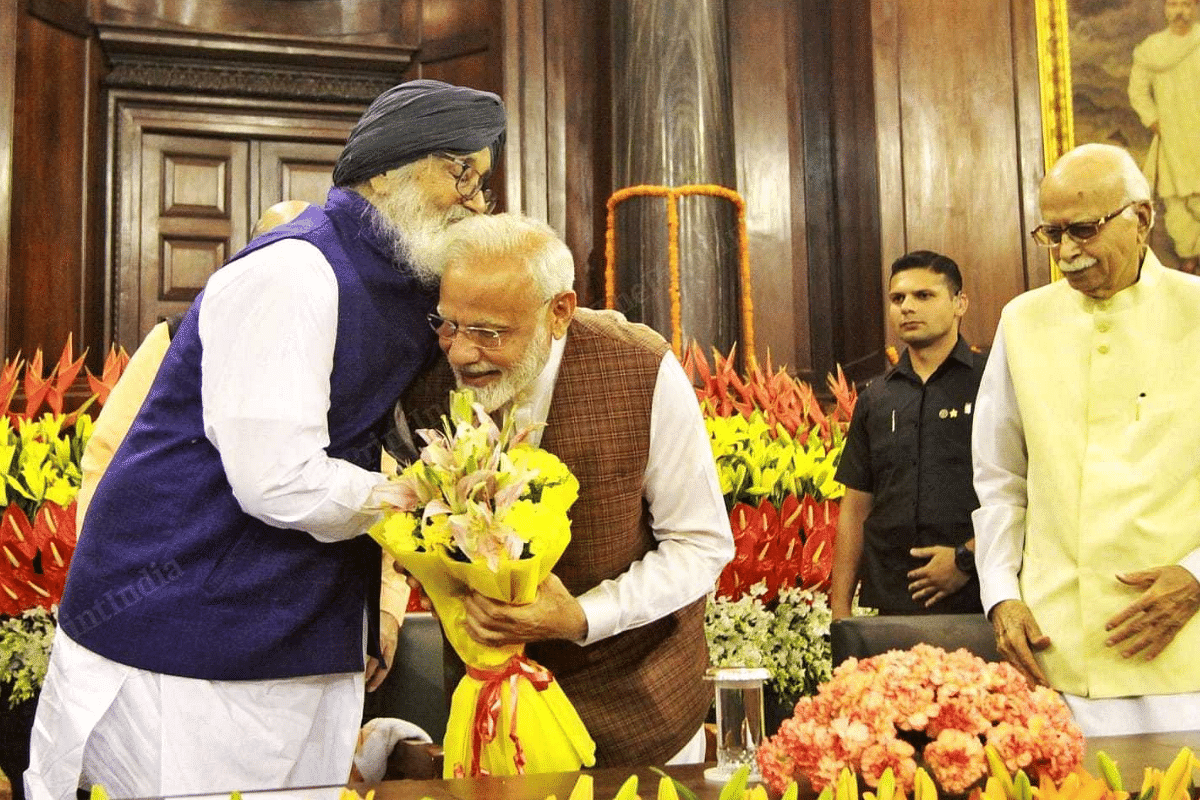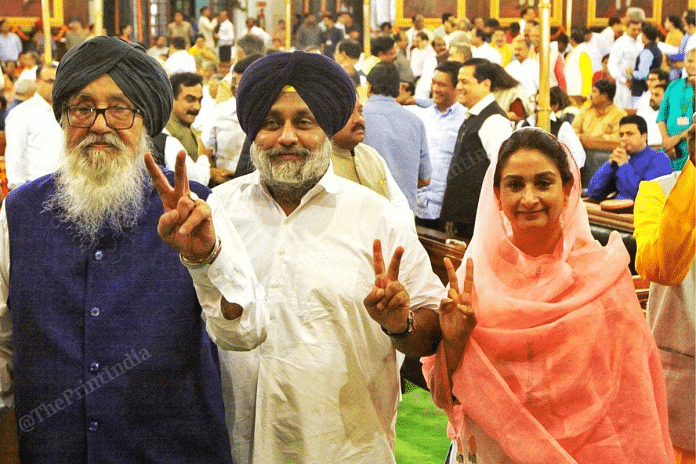Chandigarh: During his lifetime Shiromani Akali Dal (SAD) patriarch Parkash Singh Badal was not only a witness to, but an active participant in the most important events in the history of post-partition Punjab.
This included the Punjabi Suba movement of the 1950s, the Indo-Pakistan wars (1965, 1971), reorganisation of states (1966), the Green Revolution, the Naxalite movement, the Dharam Yudh morcha (1982), Operation Blue Star (1984), Operation Black Thunder (1986) and over two dark decades of militancy of the 1980s and 1990s.
His death Tuesday evening marks the end of an era of 70 years in Punjab’s politics.
The five-time Chief Minister of Punjab died at a private hospital in Mohali at the age of 95. He was admitted to the hospital on 16 April following breathing difficulties. He had been hospitalised with similar complaints in February and June last year.
Badal was the grand old master of Punjab’s dusty rustic, rural politics and his greatest strength as a politician lay in remaining amid people whom he met in hordes through the day, in or out of power. But most of all, it was his completely self-effacing demeanour and grace, and a rare infectious smile that disarmed the staunchest of critics and opponents.
Punjab’s shrewdest politician
A Dhillon Jat Sikh belonging to an agriculture family, Badal’s birth district Muktsar in Faridkot went on to become his strongest political bastions.
Badal towered over the Shiromani Akali Dal, the second oldest party in the country formed in 1920 out of the Gurdwara Reform Movement. Though over the years the party was headed by stalwarts like Harchand Singh Longowal, Gurcharan Singh Tohra, Jagdev Singh Talwandi and Surjit Singh Barnala, Badal ended up dominating the party running it now for almost three decades.
Though a powerful orator on stage, Badal’s personal interactions with people was singularly bereft of any vanity or egotism. But it was his mastery over understanding people and his ability to demolish his political opponents subtly that made him one of Punjab’s shrewdest politicians.
His influence over Sikh and gurdwara politics loomed large through the Shiromani Gurdwara Parbandhak Committee (SGPC). Ever since SAD’s reins went to Badal in 1996, the party’s control over SGPC and consequently on Sikh affairs remained undisputed.
Badal’s lasting solution to the danger of a Hindu-Sikh divide in Punjab was to align his Sikh party with the Bharatiya Janata Party (earlier Jan Sangh/Janata Party). The coalition lasted for over four decades, ending in 2021 over the issue of the three Central farm laws that Punjab farmers protested against vociferously.
An undying advocate of agriculture subsidies and free power to farmers, and for the Jat Sikh peasantry, which was the SAD’s core vote bank, Badal was not only the saviour of their religion but also their land and crops.
At the national level, Badal cast his lot with the National Democratic Alliance (NDA) and remained a Union minister in the Morarji Desai-led Janata Party government in 1977 and lent support to the Atal Bihari Vajpayee government in 1996. He was a staunch votary of increased power for the states and fought for a stronger federal structure on almost all platforms at the centre.

His political journey
After graduating from Forman Christian College, Lahore, Badal’s political career started as a sarpanch in 1947 when he was just 20 years old. He won his first assembly election from Malout in 1957 at a time when the SAD had joined hands with the Congress as part of the Regional Formula exercise.
Sant Fateh Singh, who wrested the SAD from Master Tara Singh, had in 1967 managed to break the political dominance of the Congress in Punjab when Gurnam Singh became the first non-Congress chief minister of Punjab, paving the way for Badal who though lost the elections in 1967, won the Gidderbaha seat during the 1969 mid-term polls.
A 43-year-old Badal became chief minister for the first time in March 1970 heading the Akali Dal (Sant Fateh Singh)-Jan Sangh coalition. His stint lasted a little over a year till June 1971. In 1972, when the Congress came back to power in Punjab under Zail Singh, Badal, by now a third time MLA, became leader of the Opposition.
In 1975, he was among the prominent leaders who led the opposition against former Prime Minister Indira Gandhi when she imposed the Emergency. He launched the “Save Democracy Morcha” and was arrested and jailed.
Badal became the chief minister of Punjab for a second time in 1977 heading the Akali Dal-Janta Party coalition, but his government could not last a full five-year term.
In 1980, Punjab state assembly under Badal was dissolved along with 12 other states following Indira Gandhi’s comeback. In the assembly elections that followed, the Congress under Darbara Singh came to power and Badal became Leader of the Opposition.
Also Read: ‘AAP’s Taliban regime,’ cry Oppn as cops yet to arrest culprits who chopped off man’s fingers
Moderate pacifist
During the rise of ‘militant’ Jarnail Singh Bhindranwale, Badal was part of the Shiromani Akali Dal “triumvirate” that included Longowal and Tohra.
While Tohra was seen as openly supporting Bhindranwale, Badal and Longowal maintained a moderate stance. However, unlike Longowal who was involved in the day to day activities in the Golden Temple ahead of the Operation Blue Star in June 1984 (when the army stormed the temple to flush out militants), Badal remained aloof and unattached.
While both Longowal and Tohra were in the Golden Temple premises during Operation Blue Star, Badal was at his village.
He remained, till his last, a moderate Akali whose politics, though based mostly on religion, never supported extremism of any kind. Maintaining peace and harmony in Punjab remained his top agenda.
A year after Surjit Singh Barnala became the chief minister of the first non-coalition independent Akali Dal government in Punjab in 1985, Badal split the Akali Dal forming SAD (Badal) leaving Barnala’s ministry in a minority forcing him to take the Congress’s support.
Panth to Punjabiat and populism
Badal became the chief minister of Punjab for the third time in 1997. His was the first non-Congress government in Punjab to complete a full term, lending the much-needed political stability to a state that had just come out of the throes of militancy.
Having paid a huge price for the heady mixture of religion and politics, the Moga declaration of 1996 marked a major shift in Badal’s politics — Punjabiat and not panth became the key.
Badal changed the demography of the Akali Dal to include people from all religions. The result was Akali-BJP’s huge success in the 1997 elections winning 75 of the 117 assembly seats. Badal won from the two seats he contested — Qila Raipur and Lambi.
In 2002, the Congress defeated the SAD-BJP alliance and Captain Amarinder Singh became chief minister of Punjab and Badal became Leader of the Opposition for the third time.
Badal came back to power in 2007 and 2012 and headed, for the first time in the history of Punjab, two consecutive terms of a party in power.
In 2012, he became the only person in Punjab politics to have been the youngest chief minister of Punjab at 43 in 1970 and the oldest chief minister of Punjab at the age of 84.
By 2007, populism had become SAD’s hallmark and Badal returned to power riding on the hugely popular “atta dal” and “shagun” schemes he announced for the poor.
Badal’s foreign educated MP son, Sukhbir, who was clearly being groomed as an heir apparent, was made head of the party in 2008 and ahead of the 2012 assembly polls, he ensured that economy and development become the party’s driving force.
Also Read: Rahul’s Golden Temple visit sparks row over Blue Star, anti-Sikh riots — ‘family’s gory history’
Biggest setbacks
Just when SAD had firmly put the Sikh panthic politics in the background, it became clear in the events post 2015 that the panth had not forgotten the party’s history.
SAD suffered its biggest setback when a series of incidents of sacrilege of the Guru Granth Sahib (considered to be a living Guru by the Sikhs) took place during Badal’s watch as the CM.
Badal was seen to have done nothing to bring the culprits to book and Sukhbir was seen hobnobbing with the Dera Sacha Sauda chief Gurmeet Ram Rahim — a sworn enemy of the Sikhs — for votes.
The panth never forgave Badal and the party lost abysmally in 2017 and 2022. Badal managed to retain his home seat Lambi in 2017, but lost it to the Aam Aadmi Party in 2022 when at 94 he was the oldest candidate in the fray. Badal had tasted electoral defeat for the first time since 1969.
Badal is survived by his son Sukhbir Singh Badal who is currently the president of the Shiromani Akali Dal and daughter Preneet Kaur, who is married to Adaish Partap Singh Kairon, grandson of former Congress Chief Minister Partap Singh Kairon.
Badal had lost his wife Surinder Kaur to cancer in 2011. His elder brother Gurdas, to whom he was very close, had passed away in 2020. Gurdas Badal’s son Manpreet Badal had parted ways from the SAD in 2010 when it became clear that Sukhbir and not Manpreet would be carrying Parkash Singh Badal’s legacy forward.
Legendary time discipline, memory for people
An early riser, Badal’s discipline of maintaining time and schedule to the minute is legendary. Punjab’s bureaucrats often recall how as the chief minister he would call them up early in the morning having read a news report demanding immediate action on it.
Farming remained his only hobby till the end, taking a personal and keen interest in his fruit and bee farms.
A frugal eater who never missed a day of light exercise, his boundless energy and his phenomenal memory of people, even those whom he had met briefly, will continue to generate awe and respect for years.
(Edited by Richa Mishra)



